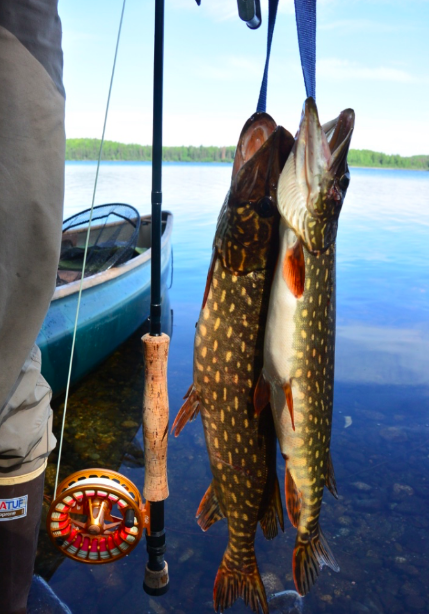By Eric Booton
I hear the dark call of a common loo
n behind me as I cast and can’t help but recall the family trips in Wisconsin and Minnesota where the song of a loon was as important to my grandma Betty as catching a fish is to me. Just one loon or one fish, and the day was deemed a success.
There is a realistic chance my memory is clouded, but the day I caught my first northern pike in Minnesota coincides with my first conscious memory of hearing a loon call. Tonight, the eerie call of the loon is a good omen.
Shallow water, shaded by low hanging brush with submerged logs and a maze of emerging grass, this is the home of an ambush predator. I anticipate the fierce strike before I even cast the fly and am ready to set the hook the moment my fly smacks the water. My eyes are fixated on the fly, the rabbit fur and flashabou of my gaudy leech pattern pulse with each quick strip of the line. My fly is nothing more than a lie, an eye-catching falsehood with a deadly secret, haphazardly swimming through the olive water until a white mouth disrupts the monocolor canvas and engulfs the entire streamer. Hook set, fish on!
I think I love northern pike fishing. Short leaders and wire tippet. Teeth and vicious strikes. What’s not to love? Northerns are ready to chomp the biggest, nastiest streamer in your fly box. Lucky for me, fortuitously big, nasty streamers are my favorite fly to both tie and cast. With a diverse taste for pretty much anything big and moving, I have confidence pike will still chase down even the most ridiculous of creations that I have pieced together when my wife tells me to get creative at the vise.
Being lower on the food chain in this lake must be terrifying, invasive apex predators have worked their way into the system and have rooted in for the long haul, wreaking havoc on juvenile salmon and trout populations. Northern pike are not native to this area of Alaska, and they have fully disrupted the aquatic ecosystem. As a result, anglers are required to kill the pike they catch. I am primarily a catch-and-release guy, outside of harvesting an ethical amount of salmon for the freezer. I enjoy watching rainbow trout, grayling and Dolly Varden as they swim from my hand and disappear into the depths of the abyss. I don’t feel bad about killing members of this foreign population of water wolves. It’s weird to say out loud, but it almost feels good and it sure does taste great. Pan-fried pike makes for some fine backcountry table fare.
My wife and I did a fair amount of damage to the unwanted pike population during our recent wedding anniversary along the Nancy Lake Canoe Trail in South-central Alaska. The quaint cabin, rare sunny weather, short portages and smooth water made for an enjoyable outing and the hot pike fishing only added to the adventure. When we got back to the canoe launch, another young couple was headed out to the same cabin to which we had just said goodbye.
Noticing the rod tube in the boat, I had to dig deeper. The couple was unaware of the pike infestation and had a fly box limited to dry flies and a few woolly buggers that wouldn’t quite cut the mustard. I dug around in my bag and didn’t hesitate to pass off a lucky streamer and a wire leader.
I hope they found the same success chasing Esox lucius that we did.
Eric Booton is the sportsmen’s outreach coordinator for TU’s Alaska Program. He lives and works in Anchorage.



